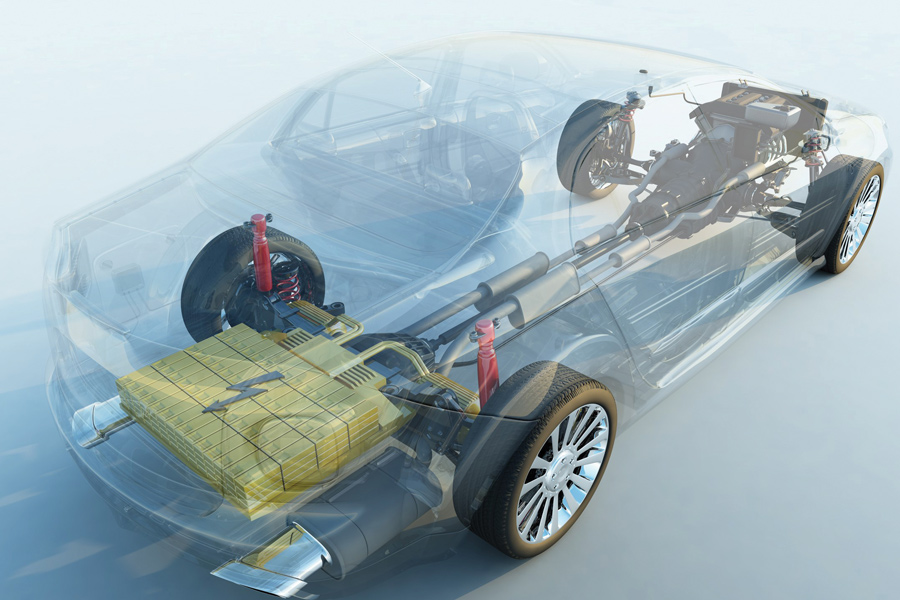
Morrow Batteries aims to be the first company in the world to commercialize a battery operating with the LNMO technology as the active cathode material. Due to its special chemistry, LNMO will have a lower cost and carbon footprint compared to batteries with a similar performance. In addition, the optimization of the electrolyte transporting positively charged ions between the cathode and anode terminals should improve the performance and competitiveness of this new generation of batteries.
“We are pleased to partner with Morrow Batteries, one of the most innovative and ambitious scale-up companies in the European battery manufacturing landscape. Our collaboration paves the way for the commercialization of their cutting-edge battery technology based on LNMO and we are excited that it will have a part of Arkema inside,” said Armand Ajdari, chief technology officer of Arkema.
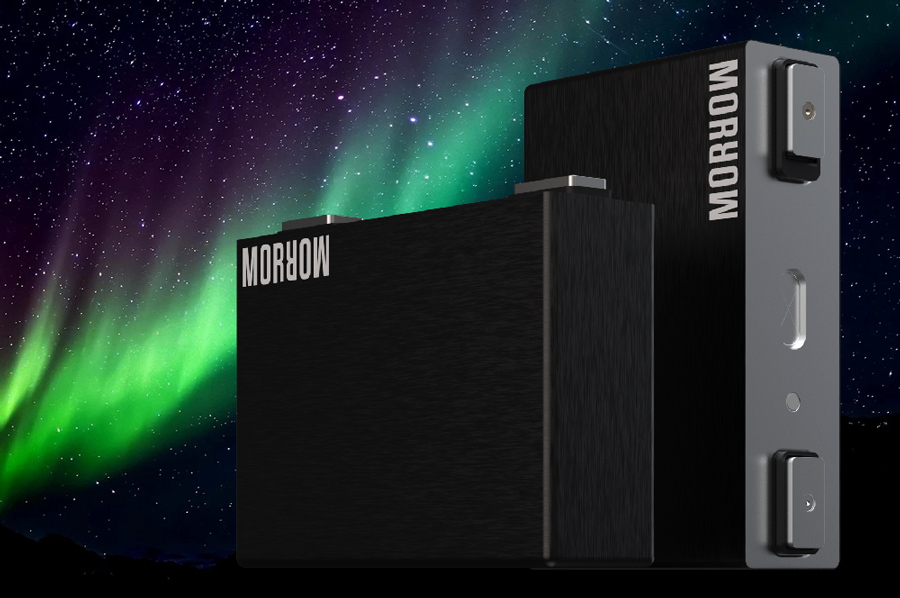
“Arkema is a world-leading supplier of PVDF binders for solvent-based, waterborne and dry processing, along with ultra-pure lithium salts to improve our cell performance. They are an excellent partner in our consortium of top-tier industry players to further optimize the performance of our high-voltage LNMO-based batteries,” said Rahul Fotedar, chief technology officer of Morrow Batteries. “Even the most advanced electrolyte formulations on the market currently will not work in a battery containing LNMO and graphite. Arkema can today offer the next blockbuster lithium salts with the highest ionic conductivity that are extremely stable at the high operating voltage of LNMO, and this is improving our large format cell performance significantly.”
This partnership will also explore the use of Arkema’s Kynar® CTO — a renewable PVDF grade with carbon derived from bio-feedstock using the mass balance approach — for the first generation of battery cells produced by Morrow. The next step is to develop water-based LNMO cathode manufacturing processes, enabled by Arkema’s Kynar® PVDF aqueous binders.
The common goal is to commercialize one of the world’s most cost-effective and sustainable battery technologies. This technology has the potential to reduce the cost of battery cells by 20 percent compared to current prices. www.arkema.com.

Delson Aeronautics envisioned a future where aircraft soar so silently they seem designed by nature, rather than humans. The company was founded by Michael Deloyer and developed with engineers Eitan Rotbart and Ammar Jessa. Their goal was to create low noise propellor blades that can be recycled, specifically for unmanned aerial vehicles (UAVs) or drones.
The Delson team developed its UAV blades over the last three years, creating thousands of iterations using additive manufacturing. The blades were made possible using MCAM’s high-strength lightweight carbon-fiber based composite, KyronMAX®.
Delson’s patent-pending drone blade design results in an average 10 dB noise reduction, making them 50 percent quieter than an equivalently sized conventional propeller blade. As a result, drone operators can get far closer to their subject without causing a disturbance. The blades are strong enough to allow drones to operate at their full power.
Benefits of these blades include:
- High tensile strength allows centrifugal loading beyond 3,000N in flight.
- Can operate in harsh and unpredictable environments from -22OF/-30OC to 120OF/50OC and in high and low humidity environments, from deserts to rain forests.
- High flexural strength and stiffness allow loading over 50 lb/ft2 (24.5 g/cm2). At the same time, the blades’ low material density and weight increases flight efficiency, responsiveness and stability.
- Strong enough for more than 1,000 operational hours.
Possible applications include wildlife conservation research, as there is interest in using drones to study animal behavior, but it isn’t always practical due to the noise. The military is another potential market, as stealth is also an essential factor. In addition, there’s an emerging market for drone delivery.
Through their Growth Garage challenges, MCAM offers their expertise, material infrastructure and resources to innovative start-ups and scale-ups to support their development of creative solutions that enable the circular economy. At the beginning of 2021, MCAM launched its first Growth Garage challenge, offering the opportunity for engineering entrepreneurs and innovators to get their ideas from pitch to product. Winners receive MCAM’s full support and expertise to help develop their projects from initial prototype to final product in three months. www.growthgarage.mcam.com.

Although concrete pipes can stand up to jacking forces and burial loads, their long-term functionality can be hampered by surrounding aggressive media. The abrasion resistance of pipes constructed from concrete materials is one point of weakness. Acidic environments also contribute to elevated abrasive wear. Applying high-density polyethylene liners to the inner surface of the pipes mitigates these issues.
Wastewater chemical concentrations expose sewage pipes to degradation by attacking their surfaces through biogenic sulfuric acid corrosion. The lack of corrosion resistance is responsible for a significant reduction in the projected life of concrete pipes. Using concrete pipes with a plastic liner eliminates the problem of biogenic sulfuric acid corrosion.
In addition to the durability benefits, designing engineers tend to control thermal actions by improving the resistance of concrete pipes using insulation. A polyethylene liner is an easy-to-apply material that can sustain most acids and alkalis at a moderate temperature, making such applications suitable for micro-tunneling activities.
One of the advantages of concrete pipes is their strength and rigidity, allowing use under extensive loads and stresses. However, the long-term performance of the pipes is a factor in the concrete mixture’s permeability. Improving the pipe’s surface resistance to external actions is vital to ensure the system’s integrity. Protective liners enhance the capability of concrete pipes to preserve their strength properties at a later age. They also improve the surface resistance to acid, abrasions and other aggressive attacks. Applying concrete protective liners to concrete pipes extends their life span, reduces the system’s construction and maintenance cost and permits more controlled life cycle cost optimization.
AGRU-ULTRA GRIP® concrete protective liner (CPL) technology is made of chemically resistant thermoplastics that, when integrated with the micro-tunneling applications, can increase the resistance of the concrete pipes to aggressive environmental attacks. The Ultra Grip liner extends the pipes’ life and reduces the life cycle cost of the project. www.agruamerica.com.
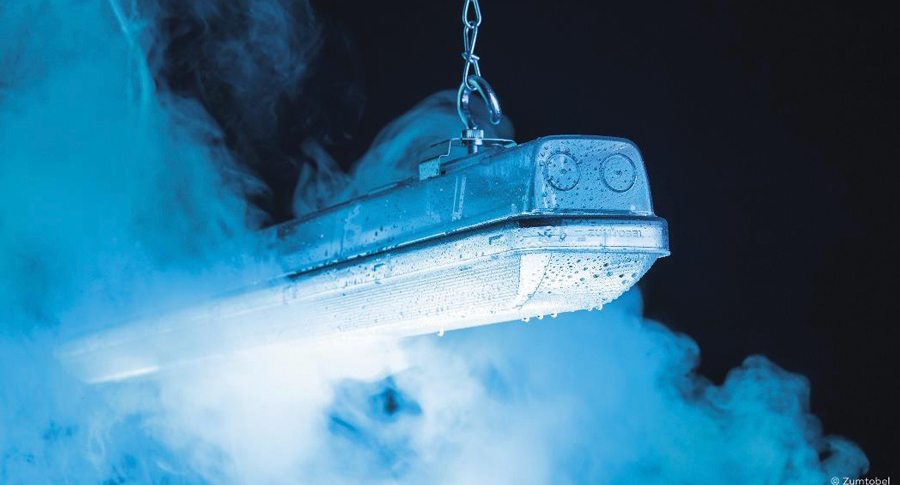
Zumtobel, an international provider of lighting solutions for commercial properties, developed its AMPHIBIA moisture-proof luminaire for a wide range of industrial applications. The long LED diffuser luminaire lights up factories, logistics centers, agricultural buildings, parking garages and much more. It is available in three versions, adapted to different areas of use. Zumtobel produces one of these versions, the AMPHIBIA PM, from ACRYLITE® molding compounds from Röhm in the Americas. “Our material meets the high standards needed for industrial lighting and also offers outstanding lighting properties,” said Andrea Fruth, senior product manager lighting, extrusion, optics in the Molding Compounds business unit of Röhm GmbH.
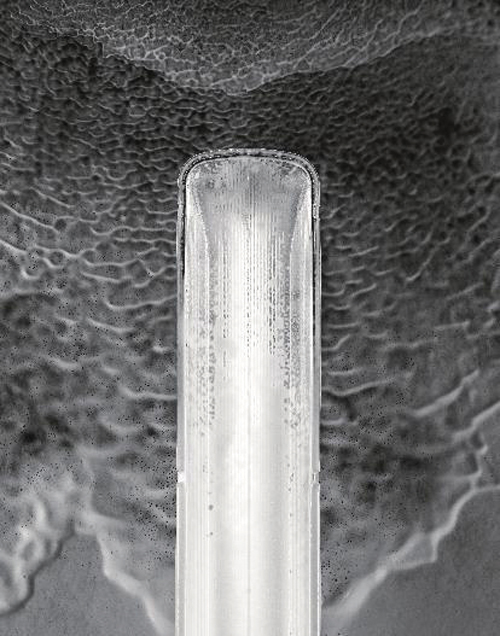
Versatility is just one of the reasons why Zumtobel chose ACRYLITE. “We value ACRYLITE Resist zk5BR for its very high transparency,” said Escourrou. “PMMA’s high UV resistance is also an advantage for luminaires used outdoors and in covered outdoor areas, such as in agricultural settings.” This is because the material’s integral UV protection allows ACRYLITE to retain its optical properties permanently, without weather conditions causing it to become yellow or brittle.
Zumtobel’s experts have developed a range of light scenarios for the AMPHIBIA series, tailored to various room dimensions and ceiling heights. For example, the luminaire can be equipped with narrow beam angle optics for illuminating high-shelf logistics centers.
ACRYLITE Resist zk5BR is transparent and, combined with its high surface reproduction accuracy in injection molding, the special molding compound is suitable for high-precision optical components like this. In the AMPHIBIA luminaires, linear microstructures at the bottom of the transparent cover guide the light to cover a deep or wide area, exactly as needed.
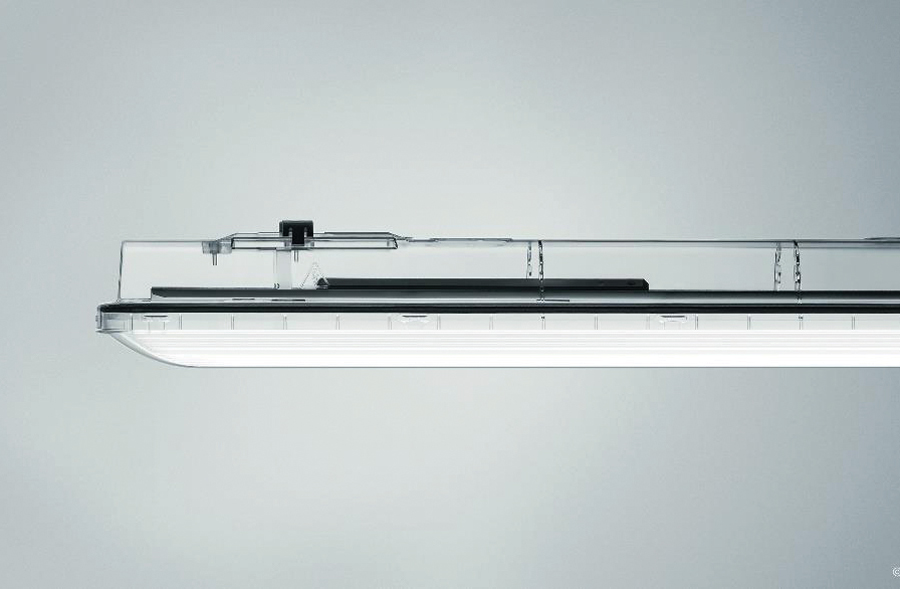
The lifespan of industrial lighting depends not only on the material’s resistance, but also on the product being able to withstand dirt and moisture and be easy to clean. Designer Stefan Ambrosius and his development team designed AMPHIBIA’s geometry in such a way that as little dirt as possible adheres to it while water runs off the smooth surfaces and rounded edges. With its robust housing, which keeps out all dust and water, AMPHIBIA meets the requirements for the IP66 safety class and can withstand the water jet from a pressure cleaner.
The fact that the entire luminaire is made from transparent components also has a practical reason when it comes to cleaning: “You can see from below whether dirt has collected on the top of the light and needs to be cleaned. That was one of the customer’s hygiene requirements,” explained Escourrou. “The PMMA variant offers outstanding resistance against a large number of chemicals that are commonly used in food processing plants, including cleaning agents.” With its resistance to ammonia, AMPHIBIA PM meets the international standards for the food industry and the standards of the German Agricultural Society for lighting in stables. With a temperature tolerance of 14°F/10°C to 95°F/35°C, it is also suitable for many other applications. www.roehm.com.


The solution had to:
- Replace problematic fiberboard material with a material that silicone would not adhere to.
- Withstand warehouse handling and transport.
- Be reusable for closed-loop manufacturing.
- Be customizable for dimensions and load weights.
Liberty Plastics, Inc. developed a custom manufacturing solution using HDPE corrugated plastic to replace the problematic fiberboard material. The extruded single-face corrugated plastic was conditioned with a surface treatment to meet the customer’s adhesion requirements and then cut into custom-sized strips. Treating the pieces allowed the glass assemblies to be successfully stacked and fully cure during transport without the silicon adhering to the board. The durability of the HDPE material withstands the additional wear and tear of handling and transportation to create a returnable and reusable closed-loop solution. The solution:
- Replaced fiberboard with HDPE plastic.
- Resolved silicone compound adhering to glass material with applied treatment process.
- Improved operational efficiencies and costs.